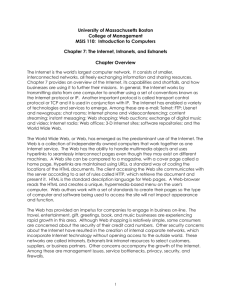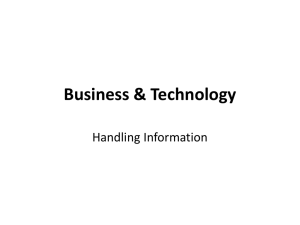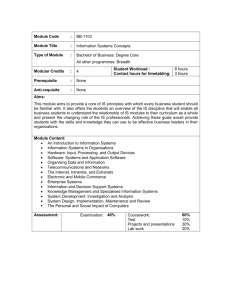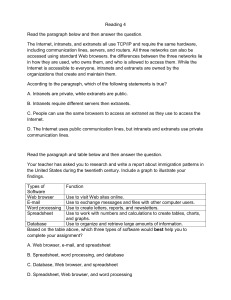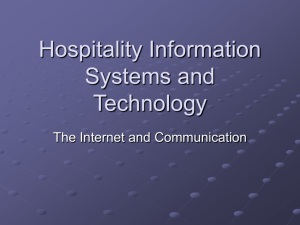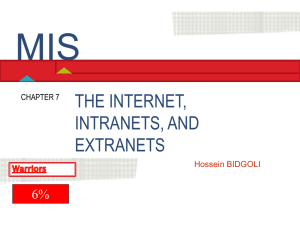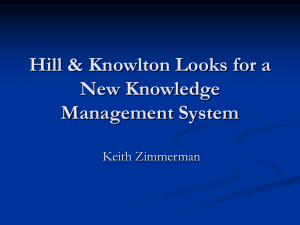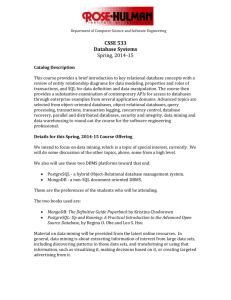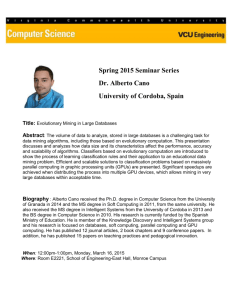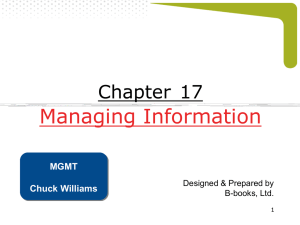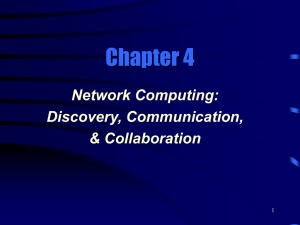(IS) / Information Technology
advertisement
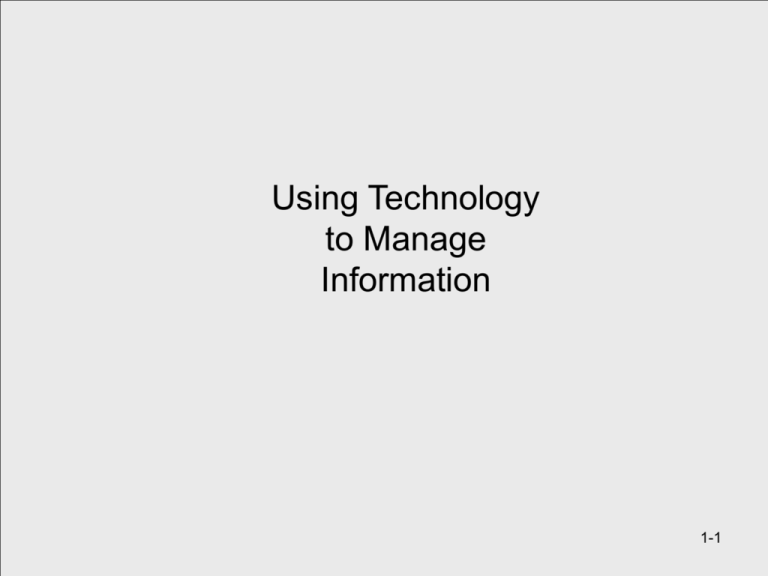
Using Technology to Manage Information 1-1 Learning Objectives 1. Define and understand the terms Data Processing, Information Systems (IS) / Information Technology (IT) 2. Define and describe the components of IS: • People (IT positions, careers) • Data (databases, data warehouse, data mining) • Networks (Intranets, Extranets, Client/Server) • Software (Shareware, Freeware) 3. Describe security issues with information systems 1-2 Information Systems / Technology • Data Processing - Early name for business technology used to support existing processes and primarily to improve the flow of financial information • Information Systems (IS) – Combination of Information technology and business processes that are designed to help people collect, create and distribute useful information • Information Technology (IT) - Hardware, software and telecommunications network technologies used to support business processes 1-3 What are Information Systems/Technologies? - A combination of technical components, built and used by people to collect, create, and distribute useful data 1-4 What are Information Systems/Technologies? Virtualization: Accessibility through technology that allows business to be conducted independent of location. 1-5 People: Three Competencies of IS Professionals Technical • Knowledge of hardware, software, networking, and security • Most IS professionals are not deep technical experts but can direct/manage others with the required technical skills Business • Understand the nature of business including process, management, social, and communication domains • Unique skills over those with only technical skills Systems • Knowledge of approaches and methods, also possess critical thinking and problem solving skills necessary to build and integrate large information systems • Unique skills over those with only technical or business skills 1-6 IS/IT Professionals vs. Other Technology Professionals 1-7 Information Systems Professionals Careers in information systems require interpersonal, business, and technical skills and pay well 1-8 Information Systems Professionals The Occupational Outlook Quarterly forecasts computer-related careers will continue as one of the two areas with the fastest growth (the other is health care). (Winter 2005-2006) 1-9 Executive Roles in Information Systems CEO Chief Executive Officer COO CFO CIO Chief Operations Officer Chief Financial Officer Chief Information Officer • • • • Manages IT Organization and Operations Forecasts IT Needs from Business Strategy Sets Direction for IT Architecture and Organization Plans, Designs and Delivers IT throughout the firm 1-10 Information Systems: Turn Data into Information Data Information • Raw material • Unformatted information • Generally has no context • Processed material • Formatted information • Data given context Ticket sales of a band on Examples tour 1-11 Sales report by region and venue…tells us which venue is the most profitable Database Technology Database - an organized collection of logically related data (Hoffer et al. 8th ed) • A collection of related data organized in a way that makes it valuable and useful • Allows organizations to retrieve, store, and analyze information easily • Is vital to an organization’s success in running operations and making decisions Data warehouse – an integrated set of related databases containing historical data that is used to support managerial decision-making 1-12 View of a Database Table Attribute (One Column) Attribute Type Record (One Row) 1-13 Organizational Use of Databases Informational Operational Extract Data Department Databases Data Warehouse • Extracted department transactions from many databases • Used for business analysis and data mining • Stores day-to-day department transactions • Used primarily by departments 1-14 Data Mining Data Mining • Process of finding hidden patterns in data (often using data warehouses) • Is a technique companies use to analyze information to better understand their customers, products, markets, or any other phase of their business for which they have data • With data mining tools you can graphically drill down, sort or extract data based on certain conditions, perform a variety of statistical analysis 1-15 Data / Information Quality Information – Four Key Characteristics • Quality: Accurate and reliable • Completeness: Adequate information for decision-making without information overload • Timeliness: Information must reach recipients quickly • Relevance: Information must be appropriate for the decision-making task 1-16 Networks Client/Server Computing - Computing systems that allow personal computers (clients) to obtain needed information from databases in a central computer (the server). • Ex. web servers and a client with a browser Internet – A network of networks, with no central computer. No one owns the Internet. World Wide Web – a means of accessing, organizing, and moving through the information in the Internet 1-17 World Wide Web - Architecture 1-18 Intranets Intranets • A companywide network, closed to public access, that uses Internet-type technology • An internal, private network using Web technologies to securely transmit information within the organization. • This private internal Web limits viewing access to authorized users within the organization Intranet Benefits • Improved information access to authorized users • Improved timeliness and accuracy of information • Global reach allowing employees access from anywhere • Cross-platform integration • Low cost deployment • Positive return on investment 1-19 Intranet Architecture 1-20 Intranets • myWSU – my.wsu.edu • WSU Employee Intranet Example: – www.ba.wsu.edu/webpbs/index.html 1-21 Extranets Extranets • Semiprivate network that uses Internet technology and allows more than one company to access the same information • Extranets are secure networks that provide customers, suppliers, and employees with access to internal systems • Two or more Intranets Extranet Benefits • Improves timeliness and accuracy of communications reducing errors and misunderstandings • Uses standard web protocols allowing disparate computing platforms to communicate without additional investments • Easy to use, requires little training • Used to automate transactions, reducing cost and cycle time • Can replace EDI for small to medium size firms 1-22 Extranet System Architecture Virtual Private Network • (VPN) is a secure network technique to protect extranet communications • Uses a technique called tunneling to encapsulate, encrypt, and transmit data over the Internet • Requires server authentication (verify user with password) to allow operation 1-23 Extranet – Enterprise Portal • Boeing Enterprise Portal Example • www.boeing.com/special/bpn/index.html 1-24 Internet Connectivity Broadband Technology Technology that offers users a continuous connection to the Internet and allows them to send and receive mammoth files that include voice, video, and data much faster than ever before Internet Research User Frustration After 1995, increases in personal and business traffic began congesting the network primarily used for research Internet2 University Corporation for Advanced Internet Development (UCAID) was formed to lead the design and development of an private high-speed alternative to the public Internet. Runs more than 22,000 times faster and uses very-highspeed backbone network service (vBNS) 1-25 Software Software Programs that control the basic functions of computer hardware and let the user perform a specific task or operation. Software can be either proprietary or opensource. Commercial Software that is copyrighted and licensed •Ex. MS Office, Windows, SPSS Shareware Software that is copyrighted but distributed to potential customers free of charge •Ex. Mozilla Firefox Freeware (public domain software) Software that is not copyrighted and free for the taking 1-26 Security Threat: Viruses Viruses • A piece of programming code inserted into other programming to cause some unexpected and for the victim, usually undesirable event. • Programs that can attack a computer and/or a network and delete information, disable software, use up all system resources, etc. Prevention Steps: • • • • Install AntiVirus software No Disk Sharing Delete Suspicious Email Messages Report Viruses 1-27 Security Threat: Cookies and Spyware Cookies A message passed to a Web browser from a Web server. Used by legitimate programs to store state and user information (such as registration data or user preferences) • Problems: can be used to track user activities • Prevention: browser settings, firewalls Spyware Any software that covertly gathers information about a user through an Internet connection without the users knowledge • Problems: uses memory resources, uses bandwidth, and can cause system instability • Prevention: Firewalls and anit-Spyware software 1-28 Staying Current with IS News Great sources for IS current information: •www.informationweek.com •www.computerworld.com •www.cio.com Or general business sites: •www.businessweek.com •www.wsj.com IS Terms: www.webopedia.com 1-29 1-30
